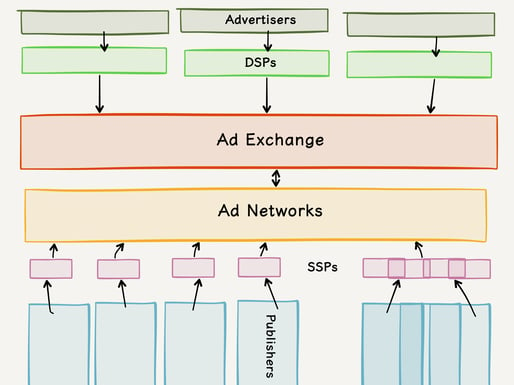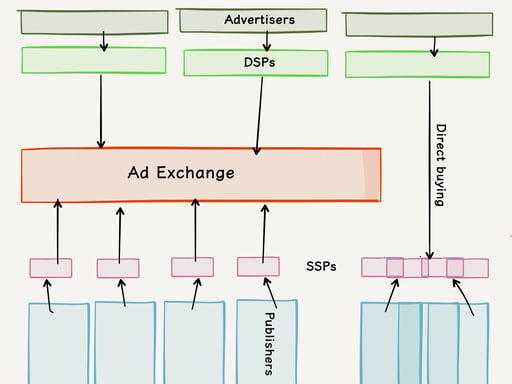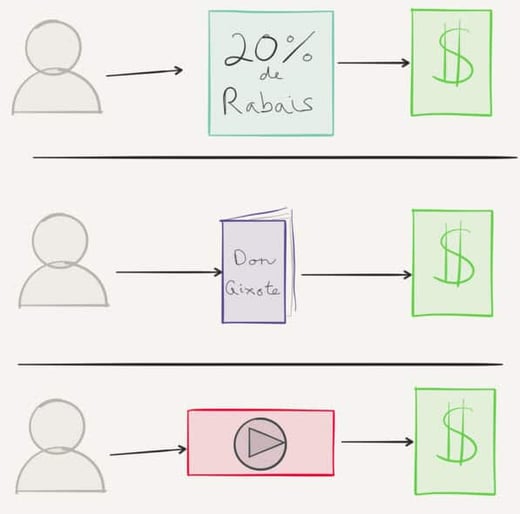Content blocking is the best thing that could have happened to digital marketing
In mid-October the IAB (Internet Advertising Bureau) saw fit to rethink its position on content blocking, which until then had consisted simply of stark opposition. Their vision changed: “We messed up.” According to their Vice President of Technology, advertisers and ad tech companies had lost track of the most important part of the Internet: the trust and satisfaction of users. So, to make amends, the IAB introduced a new program to develop standards that would be more respectful of the user experience, L.E.A.N. ads (stands for Light, Encrypted, Ad Choice Supported, Non-invasive ads).
A short time later, Google announced, with great fanfare, a new technology that would offer a web navigation experience that rivaled native apps in speed: Accelerated Mobile Pages. This announcement was a response to Facebook’s Instant Articles, Apple News, and the performance issues motivating many users to install ad blockers, specifically the poor quality of the mobile experience in terms of page load speed and respect for the user experience.
Even though these initiatives address the root causes of content blocking, there’s no guarantee that they will reduce users’ adoption of these tools in any appreciable way, particularly among the most lucrative segments (the more educated, more affluent, etc.). The use of content blockers has been linked to an 11% loss in revenue. Considering that for the “fat middle” – average sized publications with large editorial teams – even a moderate loss of revenue can spell the end, we can expect that advertisers and editors will be examining their practices to ensure that they are maximizing revenues.
Smaller, but higher-quality markets
The main effect of content blockers is to prevent the execution of scripts and the downloading of resources from third parties (for example, ad networks and servers). In doing so, these filters effectively cut off advertisers’ ability to create and reach audiences across the web.
Even if media outlets are no longer able to monetize their traffic through ad networks, it is highly improbable that advertising will disappear from online media altogether. Rather, we can expect major changes in the way ads are bought and delivered, particularly because of the increasingly important role publishers are playing in audience creation and ad delivery.
To thwart the effect of third party content blockers, publishers are accelerating their adoption of native content. What’s more, we’ll soon see publishers developing the ability to analyze their visitor behaviour and build audiences so that not only will a premium be demanded when an ad is displayed in a section, but also when it’s suggested to a particular individual. In short, they will have to adopt a strategy similar to Facebook – creating specific ad formats and placements for very specific audiences.
The main problem with native formats is that it’s difficult to automate the purchase of ad placements across the web, but that should be counter-balanced by a better quality of targeting. I doubt if this type of placement will disappear, but the delivery method will change: these ads will no longer be delivered directly to a page through an ad server, but rather will be input to a partner’s CMS, who will then display it to the right person at the right time.
These “predictions” may seem a long way off, but already important publishers like Vox (owner of The Verge, Re/Code, Vox.com, and a slew of other major web properties) have announced that they will no longer sell programmatic ads based on the current model, and are currently looking for a new model.


It’s important to understand: this alternative is far from a cure-all, because the disappearance – or at least the reduced effectiveness – of services to build audiences from a single cookie delivery source (for example, ad networks) will make it harder to acquire qualified visitors. In short, since publishers will be the ones in the best position to monitor visitors’ behaviour and place cookies on visitors’ devices, instead of connecting to a few services that are present everywhere, it would be better to connect to hundreds (if not thousands) of more interesting sites.
To counter this fragmentation and still maintain control over your audience, it takes two tools:
- First off, a DMP (Data Management Platform – a system to manage cookies and audience information). For publishers as much as for brands, DMPs will take on an important strategic role as the source of truth for audiences.
- Next, you’ll need cookie matching services like LiveRamp, to reconcile different cookies, often by using pseudonymized personal information, like a numeric email.
In the short term, the degree of sophistication needed to put this type of exchange in place will considerably reduce the quantity of inventory available on the market. However, this decrease in the amount of inventory should thankfully be accompanied by an increase in its quality.
Increased pressure to identify the “real” KPIs
The main problem with the growing role of publishers in the delivery of ads is fraud. Meaning that publishers could report falsely high numbers, or count impressions for ads that aren’t displayed. This is a problem that we very much see even today, in systems like ad servers and exchanges. We can therefore expect to see the precarious balance that currently exists collapse completely when these measures are blocked.
For brand campaigns, this situation is at risk of coming to pass. However, performance based campaigns can avoid this pitfall by changing the way they evaluate the success of their campaigns, by getting closer to the actual acquisition objective, among other things. This way we can measure visits and targeting quality (using cookie matching, as mentioned earlier) rather than the number of impressions and view-throughs.
These changes would benefit all the players in this ecosystem, because they require a better understanding of each party’s goals, and because they allow you to select tactics that maximize the value offered to each party:
- Publications could be better monetized, because publishers would be forced to better understand their audience. In addition, they could be more discerning about the inventory they offer.
- Advertisers could target more specific audiences and would have an easier time monetizing traffic. Plus, the first party visitor data they collect would be more useful and relevant.
- Since it will be harder to follow someone across the web, publications will have to offer visitors good reasons to divulge personal information like email addresses. We can therefore expect to see more effort put into personalization and optimizing the navigation experience, as publishers begin to prioritize the loyalty of their audience over the amount of traffic they get.
In short, the difficulties involved in creating massive, broad audiences will force all players to create real audiences based on identifiers rather than cookies, and to optimize campaigns based on concrete objectives (purchases or submissions) rather than as a function of metrics specific to a method of delivery (like impressions). In the end, this can only benefit users.
The customer experience as a new source of growth
Unsurprisingly, the reduced number of players and the increased quality of audiences will bring about an increase in the cost per acquisition. This will be true as much for programmatic and Premium tactics as for search or native advertising, since the reallocation of programmatic budgets towards these tactics will also contribute to higher costs.
In this context, it will become more and more necessary for advertisers to see how they can optimize the impact of every dollar they invest. Specifically, they will have to focus their efforts on channels where brands can exercise more control over their properties (email, websites, mobile applications – owned media) and their communities (earned media). And, because it will be less costly to transform current customers into ambassadors than to pay to acquire new ones, it will be necessary to invest more effort into better understanding and serving current customers.
The key to this approach is in recognizing that earning customer satisfaction isn’t just about offering discounts and promotions, but more about providing an offer that’s in line with the desires of each different customer segment. As such, it’s well worth restructuring your offers to maximize the satisfaction of your customers, and by extension, their profitability for the company.
Here’s an example. For some customers of an organization, let’s say the Grands Ballets Canadiens, the word ballet is synonymous with night out. The organization could therefore establish partnerships with restaurants or events, for example Montréal à Table, to offer packages for a night out. If, on the other hand, the ballet is a passion that customers like to share with a friend, the organization could offer seat upgrades to members who invite a friend who’s never attended the ballet. And for customers who are drawn more by the artistic aspect, the organization could create short videos or write-ups to share with members.
Essentially, the idea is to deploy a range of tactics that offer value to customers, with the intention of retaining them, increasing their level of consumption, or inciting them to bring new people to the organization through the offers they are given.

The catch is that to be able to correctly deploy this type of strategy, a brand needs to know its customers and their needs. It needs to know the key elements needed to create a positive user experience, and use different approaches to convert and retain customers. This requires us to start thinking in terms of customer management (what would my customers like?) rather than in terms of audience management (for example, couples in their 50s with an annual family income of more than $150,000 are more likely to buy tickets to the ballet…).
Currently, approaches are not aligned with this objective. Brands and their partners alike will need to adjust their practices to better manage this new reality.
Developing a road map for audience management
To properly effect this transition, brands need to master two important things:
- Technology
- Marketing
As mentioned previously, content blocking reduces the effectiveness of ad networks and servers to create audiences. It will therefore no longer be possible to rely on third parties to provide quality data to reach a desired public.
In order to be able to properly monitor and target audiences, brands will need to develop these abilities internally. A solid mastery of digital marketing technology (Analytics, CRM, DMP, and ad servers) and, above all, the way they interconnect, is a prerequisite for the execution of this type of strategy. Using these technologies in a silo will become an increasingly costly luxury.
From a marketing perspective, we will need to change our approach to ensure we know our customers, not only in terms of socio-demographics (like age, gender, place of residence and employer) but also in terms of their wants and needs. In other words:
- Having concrete knowledge of who the most loyal customers are and why
- Knowing where visitors come from and what they want
In short, part of the energy we devote to identifying correlations (a 20% discount increases conversions by 25% on Facebook) should be put towards identifying what actually gets visitors to convert (“the staging was incredible,” price, etc.).
This happens partly through the implementation of measurement tools (that allow us to know what visitors are doing) but also simply through interviews with consumers. It’s only once distinct profiles have been created that it will be possible to understand the importance of each segment of the audience, and to decide how to target them.
Content blockers have shaken the status quo. They have significantly reduced our ability to monitor and automatically target Internet users. But, in exchange, these tools force us to finally adopt a truly customer-based perspective, to the advantage of everyone involved.

-1.png)
-1.png)
-2.png)





